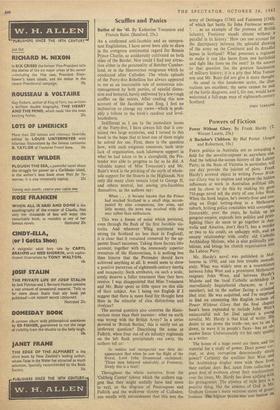Scuffles and Panics
Battles of the '45. By Katherine Tomasson and Francis Buist. (Batsford, 25s.) As a confirmed anti-Jacobite and an unrepen- tant Englishman, I have never been able to share in the evergreen sentimental regard for Bonnie Prince Charlie, so assiduously cultivated on both sides of the Border. Nor could I find any attrac- tion either in the personality of Butcher Cumber- land, or in the Hanoverian vengeance which he conducted after Culloden. The whole episode of the Forty-five Rebellion has always appeared to me as an inscrutable tale of monstrous mis- management by both parties, of squalid dissen- sion and betrayal, barely enlivened by a few rough scuffles on the moors. After reading this new account of the Jacobites' last fling, I feel no inclination to change my views—which is prob- ably a tribute to the book's candour and level- headedness.
Indifferent as I am to the immediate issues of the Forty-five, I have always felt that it con- tained two large mysteries, and I turned to this book in the hope that at least one of them might be solved for me. First, there is the question how, with such exiguous resources, such utter lack of organisation, such lukewarm support in what he had taken to be a stronghold, the Pre- tender was able to progress as far as he did. A valuable aspect of Miss Tomasson's and Mr. Buist's work is the pricking of the myth of whole- sale support for the Stuarts in the Highlands. Not only did many clans remain loyal to George II, and others neutral, but among pro-Jacobites themselves, as the authors say:
When . . . it became known that the Prince had reached Scotland in a small ship, accom- panied by nine companions, few arms, and little money, the news was received with dis- may rather than enthusiasm.
This was a frame of mind which persisted, even through the flush of the first Jacobite vic- tories. And wherever Whig sentiment was strong (in Scotland no less than in England), it is clear that it remained unmoved by the ap- parent Stuart successes. Taking these factors into account, together with the immensely superior resources of the Hanoverians, it is nothing less than bizarre that the Pretender should have achieved anything at all. It would seem to show a positive paroxysm of eighteenth-century inertia and incapacity. Such attributes, on such a scale, surely deserve a fuller treatment than they here receive. I was disappointed that Miss Tomasson and Mr. Buist spent so little space on this side of their subject. Am I being too English if I suggest that there is more food for thought here than in the minutia' of clan distinctions and rivalries?
The second question also concerns the Hano- verians more than their enemies: what on earth was wrong with the British Army? In a series devoted to 'British Battles,' this is surely not an irrelevant question? Describing the scene at Falkirk, when four out of six infantry regiments on the left flank precipitately ran away, the authors tell us:
So sudden and unexpected was their dis- appearance that when he saw the flight of the Royal, Lord John Drummond exclaimed: 'These men behaved admirably at Fontenoy. Surely this is a feint.'
Throughout the whole narrative, from the 'Coltbrig Canter' (about which the authors sug- gest that they might usefully have had more to say), to the disgrace of Prestonpans and Falkirk and the walkover victory of Culloden, one recalls with astonishment that this was the army of Dettingen (1743) and Fontenoy (1745), of which last battle Sir John Fortescue wrote:,
. . as an example of the prowess of British infantry, Fontenoy stands almost without a parallel in its history.' How can one account for the discrepancy between the splendid showing of the army on the Continent and its dreadful lapses in Scotland? What possesses a regiment to make it run like hares from one battlefield and fight like lions on the next? In the answer to that question lies the greatest fascination of military history; it is a pity that Miss Tomas- son and Mr. Buist did not give it more thought As usual in this handsome series, the illus- trations are excellent; the same cannot be said of the battle diagrams, and I, for one, would have welcomed a full-page map of eighteenth-century Scotland.
JOHN TERRAINS














































 Previous page
Previous page